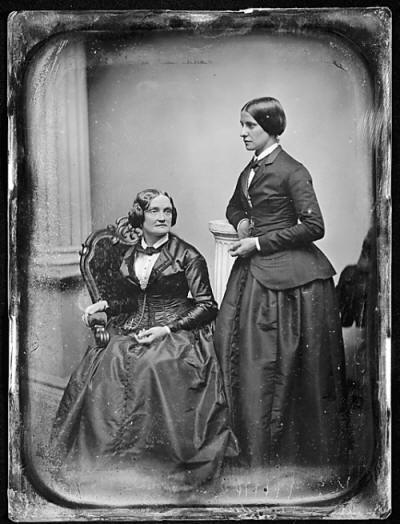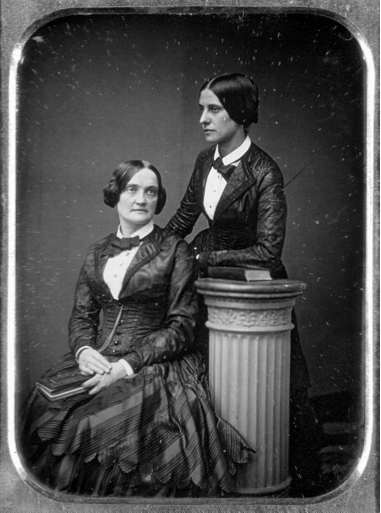

Queer Places:
Via del Corso, 28, 00187 Roma RM
Toxteth Park Cemetery, Liverpool L8 0SE, Regno Unito
 Matilda Mary Hays (8 September 1820 – 3 July 1897) was a 19th-century
English writer, journalist and part-time actress. With Elizabeth Ashurt, Hays
translated several of George
Sand's works into English. She co-founded the English Woman's Journal.
Her love interests included the actress
Charlotte Cushman,
with whom she had a 10-year relationship, and the poet
Adelaide Anne Procter. When Hays published her translation of George
Sand’s La Petite Fadette in 1851, she dedicated it to Charlotte Cushman.
William Wetmore Story, writing to his Boston friend, poet James Russell
Lowell, observed that
Charlotte Cushman,
Harriet Hosmer,
Matilda Hays, and writer
Grace Greenwood formed "a
Harem (Scarem) of emancipated females".
Matilda Mary Hays (8 September 1820 – 3 July 1897) was a 19th-century
English writer, journalist and part-time actress. With Elizabeth Ashurt, Hays
translated several of George
Sand's works into English. She co-founded the English Woman's Journal.
Her love interests included the actress
Charlotte Cushman,
with whom she had a 10-year relationship, and the poet
Adelaide Anne Procter. When Hays published her translation of George
Sand’s La Petite Fadette in 1851, she dedicated it to Charlotte Cushman.
William Wetmore Story, writing to his Boston friend, poet James Russell
Lowell, observed that
Charlotte Cushman,
Harriet Hosmer,
Matilda Hays, and writer
Grace Greenwood formed "a
Harem (Scarem) of emancipated females".
Matilda Hays was born in London on 8 September 1820,[1] the daughter of a corn merchant named John Hays.[a] Elizabeth Mary Hays was Matilda Hay's mother.[4] She was first married to Jacob Breese who died in February 1807, and she later married John Hays. Matilda's siblings were Elizabeth, Susanna and Albert. She had two half-sisters, Emma Marianne Breese and Clara Salmon,[4] who married Frederick Salmon in 1830.[5]
Hays was identified as a Creole[6] or, according to Joseph Parkes, half Creole; if this is so, at most she can only have been half Creole through her mother; her father's origins are Londoners going back at least three generations.[7][8] She wrote articles for periodicals, often regarding women's issues, starting about 1838.[1][9] The periodicals included The Mirror and Ainsworth's Magazine.[7]
Hays, influenced by George Sand, was a journalist and novelist who was "determined to use her writing to improve the condition of women." In her novel Helen Stanley, Hays wrote that until "Women teach their daughters to respect themselves,... to work for their daily bread, rather than prostitute their persons and hearts" in marriages, women would not have secure financial and social futures.[7][9]

Cushman and Hays
Hays and Charlotte Cushman met between 1846[9][c] and 1848. Soon after, they began a lesbian affair, a relationship they maintained for nearly 10 years, and in Europe were publicly known as a couple.[21] They wore tailored shirts and jackets. Matilda was often referred to by their friends as Mathew or Max.[7][20]
In 1847 Hays pursued creation of a Woman's journal, patterned after the American Godey's Lady's Book, to offer a vehicle for women writers and to provide a platform for discourse about women's rights, including better educational and occupational opportunities. Her goal was to afford "free discussion of a subject for which at that time it was impossible to obtain a hearing through ordinary channels of the Press." Charlotte Cushman and her friend, Mary Howitt, helped her explore opportunities to have the journal founded, but realized it was not quite the time to launch the journal and decided to focus her energy on advocacy for the present.[7][15]
In 1848 there was a convergence of financial need, the "small fortune" Hays received was lost due to her father's depleted financial situation,[b] and Charlotte Cushman's sister was leaving the stage, which created an acting opportunities. Charlotte's sister, Susan Webb Cushman, who played Juliet to Charlotte's Romeo, left the stage to marry a successful Liverpool scientist, James Sheridan Muspratt.[7][15] The women practiced together at the Yorkshire estate of the Duke of Devonshire for the 6 October 1848 opening in Bath. Hays acted with Cushman for just a few months, as Cushman increasingly became a star.[20]
On a tour of United States theaters in 1849, Cushman traveled with Hays, and a newspaper article praising Cushman as a “woman . . . worthy of homage and esteem” added, “Miss Cushman will be accompanied by her friend, novelist and translator, Matilda M. Hays.”
Elizabeth Barrett Browning wrote to her sister Arabel in 1852 about meeting Matilda Hays and Charlotte Cushman: “I understand that she & Miss Hayes [sic] have made vows of celibacy & of eternal attachment to each other— they live together, dress alike . . . it is a female marriage. I happened to say, ‘Well, I never heard of such a thing before.’ ‘Haven’t you?’ said Mrs Corkrane [sic], . . . ‘oh, it is by no means uncommon.’ They are on their way to Rome, so I dare say we shall see a good deal of them. Though an actress . . . Miss Cushman has an unimpeachable character.” Barrett Browning’s informant was the wife of journalist John Frazer Corkran, a correspondent for the Morning Chronicle.
On November 12, 1852, Harriet Hosmer arrived in Rome, accompanied by her father, Dr. Hiram Hosmer; Sarah Jane Clarke Lippincott, the journalist known professionally as Grace Greenwood; Virginia Vaughn, a girlhood friend from Lenox; Charlotte Cushman; Sallie Mercer, Cushman’s African-American maid and “right-hand woman”; and Matilda Hays, Cushman’s partner, a feminist reformer and translator of George Sand’s novels. The socially well-connected Vaughn had introduced Hosmer to Cushman in 1850 after a performance in Boston. Hosmer was immediately taken with this strikingly independent woman and developed a lifelong attachment to her. In a letter to her childhood friend Cornelia Crow Carr, she wrote: “Miss Cushman and Miss Hays (her friend and companion) have left Boston, and I can’t tell you how lonely I feel. I saw a great deal of them during the three weeks that they were in the city.... Isn’t it strange how we meet people in this world and become attached to them in so short a time?” Cushman and Hays represented models of creative freedom for Hosmer, who shared their residence at via del Corso 28 in Rome.
In 1852 Cushman retired from the stage and joined Hays in Rome, Italy, where the lived in an American expatriate community, made up mostly of lesbian artists and sculptors. In 1854, Hays left Cushman for Harriet Hosmer, which launched a series of jealous interactions among the three women. Hays eventually returned to live with Cushman, but the tensions between her and Cushman would never be repaired. By late 1857, Cushman was secretly involved with Emma Stebbins. One night while Cushman was writing a note, Hays walked in, suspected that the note was to Stebbins, and demanded to see it. Cushman refused and Hays became mad and chased her round the house, hitting her with her fists. The relationship ended and Hays sued Cushman, claiming that she sacrificed her career to support Cushman's career. Cushman made a payment to Hays and their relationship ended.[7][21]
Charlotte Cushman and Emma Stebbins built a life together in Rome, using the trope of domesticity to emulate the heterosexual nuclear family. In March of 1857, they traveled to Naples, a sojourn that cemented their romantic attachment. At the time, Cushman was still involved with Matilda Hays. In April, Hays fled Rome after an emotional confrontation with Cushman. By July, Stebbins and Cushman had formalized what would become a lifelong partnership. “The current of [our] two lives ran, with rare exceptions, side by side,” Stebbins would later write. “We were in Rome, as ‘travellers and pilgrims’ to the famous city.” Although theirs was not an untroubled relationship, they exchanged vows of love and fidelity in 1859. Cushman described their relationship as a marriage: “Do you not know,” she wrote to Wayman Crow, “that I am already married and wear the badge upon the finger of my left hand?”
When her relationship with Cushman ended in 1857, Hays returned to her feminist circle in London, where she helped run the English Woman’s Journal and the Society for Promoting the Employment of Women, and eventually formed another relationship with Theodosia, Dowager Lady Monson. Theodosia Blacker, Lady Monson was a promoter of women's rights who rented 19 Langham Place as a homeplace for the Langham Place group, a circle of like-minded women who gathered there. She was the last companion of Hays.
Hays was one of the co-founders and editor of the English Woman's Journal[16][17] in 1858. It was in 1858 founded by Barbara Bodichon and Bessie Rayner Parkes, with others, Bodichon being the major shareholder.[7][18]
The Society for Promoting the Employment of Women and the Victoria Press, which Hays helped found, met at the Langham Place offices of the journal. She left the journal by 1864, reputedly because of her "difficult temperament." She had often disagreed with Parkes, her co-editor, about the journal's direction.[7]
Hays also supported herself as a translator and writer, and her novel Adrienne Hope (1866) included characters based on herself and Lady Monson, Miss Reay and her constant companion, the solicitous, widowed Lady Morton. Miss Reay declares her support for women’s rights and notes, “Until quite lately a married woman was only a chattel . . . absolutely belonging to her husband. . . . The new Divorce Court has mended this state of things.”
Hays was believed to have had a love interest in Adelaide Anne Proctor, who dedicated Legends and Lyrics to her with:
Our tokens of love are for the most part barbarous, Cold and lifeless, because they do not represent our life. The only gift is a portion of thyself. Therefore let the farmer give his corn; the miner, a gem; a sailor, coral and shells; the painter, his picture; and the poet, his poem.[6]
— Emerson
She also wrote a love poem for Hays entitled, A Retrospect.[6][22] Hays oversaw the tending of Procter's grave after her death and mourned her passing throughout her later years.[7]
Hays died in Liverpool at 15 Sefton Drive in Toxteth Park, on 3 July 1897.[1][7] Although Adelaide Procter had died 30 years before Hays, the Liverpool Echo obituary stated that she had been "the dear friend of Adelaide Procter, gone before."[7]
My published books: